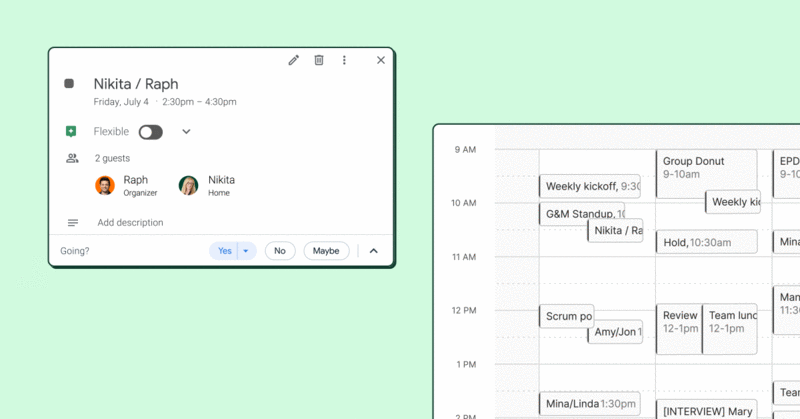According to WorkLife, the average worker spends 37% of their time in meetings or coordinating meetings. To make matters work, workers cited internal meetings as the most common recurring meeting (plus, they are the most often rescheduled, costing businesses thousands of dollars annually).
When Shopify made headlines by canceling 322,000 hours of recurring meetings from team members' calendars, workplaces everywhere noticed.
But our CEO Matt Martin said it best, “Canceling recurring meetings doesn't inherently transform how a company thinks about time – this shift must stem from a change in company-wide culture. And without that shift, I can promise one thing with complete certainty: the meetings will come back, and they’ll come back in the same disorganized and uncoordinated manner they began.”
Rather than jump to drowning, banishing, and drowning again in recurring meetings, use this guide to manage recurring meetings effectively and use them to your team’s advantage.
What are recurring meetings?
Recurring meetings are what they sound like—a series of events that occur on a regular schedule, which might include:
- Weekly
- Monthly
- Bi-weekly
- Bi-monthly
- Quarterly
- Bi-annually
- Annually
Hopefully, you get the point! Many organizations use recurring meetings for various purposes, including:
- One-on-ones
- Team check-ins
- All-hands company-wide updates
- Ongoing status updates
- Strategic planning sessions (at the leadership or executive level)
- Performance reviews
The list goes on. Recurring events are customizable and meet varying team needs, depending on how your team structures them.
Benefits of managing recurring events
Recurring events aren’t all bad news. There are plenty of benefits of managing recurring events when you manage them properly, including:
Less time spent on coordination and scheduling
One of the most appealing reasons so many of us gravitate towards setting up a recurring meeting is that creating and sending out one invite (on a repeating schedule) reduces the time we’ll spend on coordination and scheduling in the long term. Once you decide on a meeting cadence, create an invitation, and ship it off to the meeting attendees, it’s on the calendar, and you don’t have to think about the coordination and scheduling aspect again (that is, of course, unless you need to cancel or reschedule).
Ongoing collaboration and communication
Recurring meetings, primarily team check-ins, company-wide all-hands meetings, and strategic planning, can provide ongoing collaboration and communication. These meetings serve as a tool to support connection efforts and ensure the right people feel informed and equipped with the information they need. Recurring planning meetings can foster ongoing collaboration among teams that rarely spend much time together. They can be an excellent way for leaders and department heads to stay in touch and understand each team’s priorities and frustrations for better teamwork.
Increased accountability
There’s something to be said about knowing you’re accountable for attending and sharing information in a recurring session, no matter the cadence. Recurring meetings create space for shared accountability as team members come together on a set schedule to achieve a specific goal. Without these connections, accountability can easily fall to the wayside as team members dig into other work.
Tools for managing recurring meetings (2 apps you need!)
Setting up and managing recurring meetings is straightforward with today's technology and tools. For optimal productivity, we recommend using Google Calendar and Clockwise.
Setting up recurring events in Google Calendar
For example, you can easily create events in Google Calendar by adjusting the repeating event cadence using the dropdown in the event settings. Here’s how:
1. Open Google Calendar and create a new event.
2. Add the event title, time, location, notifications, permissions, description, and other details.
3. Below the event’s date and time, click the arrow next to the “Does not repeat” button. (Tip: the date you create the calendar event is the start date for your series and the first event.)
4. Choose from the available recurring events options or create a custom schedule for your date range.
5. Save and send your invitation!
According to the Google Calendar Help Center, repeating events have a limit of 730 occurrences (far more than you should ever need). We recommend setting an event end date (more on that in the best practices below!)
Managing recurring events with Clockwise
There’s a better way to manage recurring meetings without manually updating them each time in Google Calendar, and it also promotes flexible scheduling for today’s busy worker bees.
An understated trait about many recurring events is that while they should happen at a certain cadence, they aren’t always time-bound, meaning they don’t have to occur on the same day of the week at the same time each week.
Take, for example, one-on-one meetings. Let’s suppose Kacy and I have a bi-weekly one-on-one. We schedule it for 10:00 a.m. on Tuesday mornings, but sometimes, Tuesdays quickly fill with other meetings, urgent tasks, and personal responsibilities. I still want to meet with Kacy, but it doesn’t have to be on Tuesdays at 10:00 a.m. as long as we can still meet during that week. No specific date or start time is necessary!
That’s where Clockwise can help. With Clockwise, you can mark meetings as flexible and automate recurring meeting scheduling. Flexible meetings allow us to move your events to resolve conflicts, open up blocks of Focus Time, and ensure you don’t have to reschedule your recurring meeting manually. Clockwise considers several factors when moving meetings, including your Focus Time cost, meeting hours, other attendees’ meeting hours, day/time range settings, and your lunch preferences.
You can also mark single events as flexible in Clockwise, providing the functionality to flex your workday to accommodate changing priorities across your calendar.

Common challenges and solutions for managing recurring events
Like every other type of meeting, recurring meetings pose challenges worth considering and monitoring. Below are some common challenges of managing recurring events and how to prevent or address them as they arise.
Wasted time and lack of purpose
If scheduling recurring events saves time, how do these meetings potentially lead to time waste? Recurring meetings added to the calendar months ago that haven’t evolved to meet changing needs or have no real purpose do more harm than good.
You might’ve saved yourself time on the scheduling and coordination front, but now you’re stuck in a bi-weekly recurring meeting that you don’t feel you need to be part of and get no real value from. Bummer, right?
Ways you can combat this:
- Define a clear meeting purpose, goals, and agenda (yes, even if your meeting format always stays the same!) some text
- Try Atlassian’s page-led meeting Team Playbook for this
- Use a team collaboration tool like Asana to create, update, and distribute your agenda template for better visibility

Lack of attendance
Recurring meetings can take a backseat in the minds of busy workers as conflicts or a lack of perceived importance arise. This is most problematic in recurring team meetings where there are (probably) too many participants.
Ways you can combat this:
- Use Clockwise’s flexible meetings feature to automatically reschedule meetings at a time that works best for everyone
- Implement meeting ground rules for shared expectations and participation norms among your team members
3 best practices for recurring events
Here are a few final thoughts and tips to help make your recurring meetings a success:
1. Give all of your recurring events an end date
Don’t create a recurring calendar event and repeat it endlessly without asking, “Is this meeting still necessary? Do we need to adjust the cadence? Attendees? Purpose?”
There’s zero harm in setting an end date for your recurring events. You can pilot a recurring meeting for a set number of occurrences (e.g., let’s try this meeting five times) or set an event to expire after a specific end date.
If it’s still going well when you hit the number of occurrences you set, you can always extend it!
2. Limit the number of attendees
Recurring meetings become costly quickly. They can also be a real buzzkill if you have many people on the call, and many don’t find this regular time together valuable. Don’t contribute to a culture of devaluing recurring events by limiting attendees for better participation and maximum results.
3. Avoid letting rigidity get in the way
Well-run recurring meetings deserve their place in the workday, but don’t let these events become stale and immovable. Give yourself grace and space by allowing recurring meetings (when it makes sense) to be flexible ones that can shift throughout the week, thanks to the help of Clockwise.


.gif)
.png)



.png)